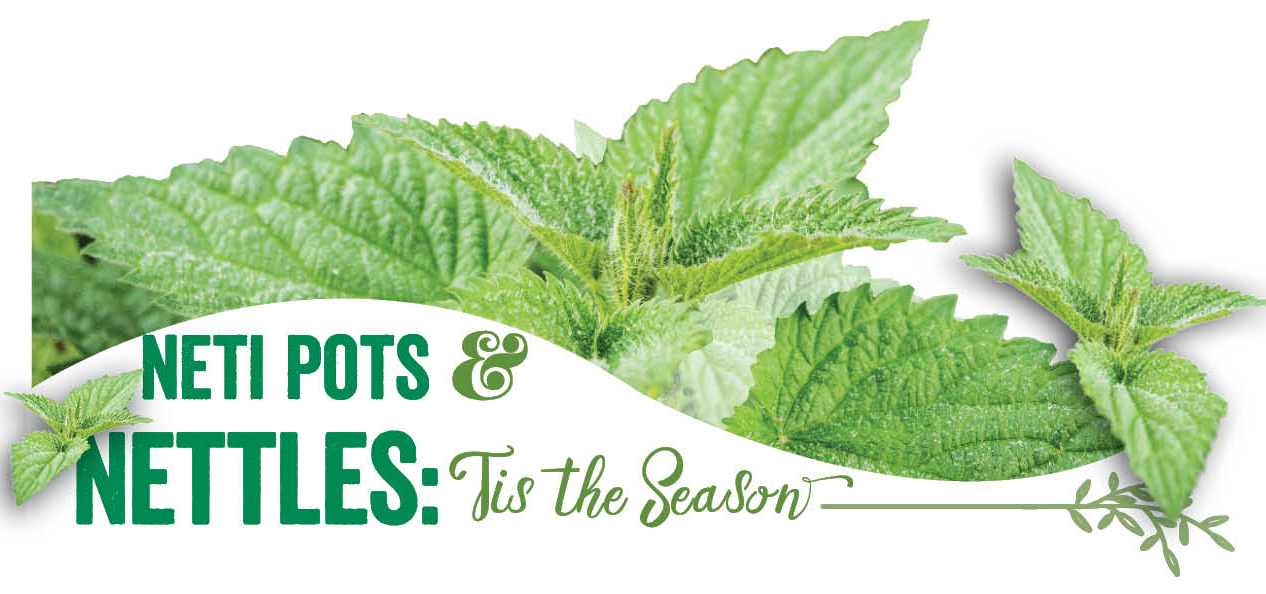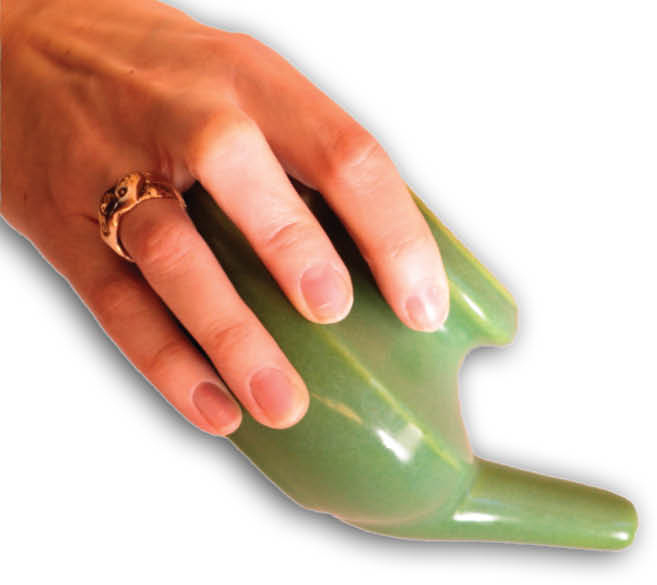
 By Gretchen Fox Schempp, Wellness Manager
By Gretchen Fox Schempp, Wellness Manager
I am one of those “lucky” people whose allergies disappear with the first frost. Maybe this is one reason I love winter and long for frozen earth come late November. Many not so lucky folks suffer all year round with allergies, from dust and mold, animal dander, certain foods and pollen. I think I can safely say that the coming of spring is welcome by all (even me), but for seasonal allergy sufferers it can open a whole new bag of symptoms to deal with.
As it is early in the season, it is a good time to talk about boosting the system to be ready for these potential invaders. Hopefully you’ve been caring for your immune system all winter long, combatting the colds and flus that are common. There are amazing things we can do with diet, exercise and supplements to boost our systems. Here we will talk about some ideas for preparing the body for the next season of the year.
Diet
One thing I do know along the lines of diet is this: Dairy and sugar consumption make my allergies worse. Studies show that high sugar consumption makes your white blood cells 40% less effective at killing germs. Sugar affects your white blood cells by competing with Vitamin C for space in those cells. The more sugar in your system the less Vitamin C can get into those cells, and this directly affects our immune system. Additionally, sugar is an inflammatory substance. There are a huge range of conditions related to low grade inflammation: arthritis, allergies, asthma, depression, irritable bowel syndrome, diabetes, stroke, cancer…the list goes on. Check out Dr. Andrew Weil’s website http://www.drweil.com/diet-nutrition/anti-inflammatory-diet-pyramid/dr-weils-anti-inflammatory-food-pyramid-2-2/ for more information on anti- inflammatory dietary suggestions.
Dairy, oh dairy, how I love you…cheese in particular, you are my BFF, I want you on a daily basis. My own little experiment a few years ago led me to find that dairy, maybe, just maybe, was indeed, NOT my best friend. Not for digestive reasons, like many have, but for respiratory reasons. I have read for years that dairy is mucous forming and is implicated in just about all respiratory issues from hayfever, sinusitis, colds, bronchitis and runny noses. Then I came across an article debunking this “myth.” (I mean, you can find anything on the internet to support whatever it is you’re wanting to think). Finally, awesome, I’m thinking, it’s all in my head, this mucous situation… It’s not the dairy…but as they say, the proof is in the pudding, or the fondue in this case. I couldn’t deny it though, that when I am eating copious amounts of cheese and other dairy creamy yumminess, I am suffering. I can’t get a good inhale and exhale in yoga. I huff and puff up the hill at home. My face is even swollen around my nose and eyes. And all those years that I suffered from March thru October with allergies to everything in the air, all the while being addicted to sugar and eating whatever was set in front of me. Hmm…a connection. It wasn’t until I did some looking at my diet, for reasons of weight loss, that I gave up the sugar and slowed down on the dairy and wheat (which is a whole other article!). As a side effect of this new diet/lifestyle, my seasonal allergies were allayed.
Assessing how certain foods affect you personally can be an involved process. There are great resources that can assist in this process. One popular method is with the Whole 30 Program. It can feel like a big commitment to change your diet in a big way, but when discomfort is the symptom, in whatever form, it may just be worth it to know more about yourself and what your triggers are. Just go to whole30.com for more information.
Exercise
Move, move, move! I can’t express enough the need for movement in our lives. Like many of you, my work is lacking in the physical, so I have to find other options to get moving. Regular physical activity can help alieve the symptoms of allergies by improving blood flow in the body, promoting the removal of allergens. Be aware of your symptoms and be sure to warm up. It just takes getting your blood pumping to help, it doesn’t have to be the most intense or challenging activity. When exercising outdoors be aware of your surroundings (grassy fields, dusty roads, etc.), pollen counts and overly windy days. These may be good times to seek out an indoor class or gym to get your sweat on.
Exercises such as Yoga and Pilates promote proper breathing and can be of great help for allergy sufferers. Perform workouts that strengthen the heart and lungs, such as resistance training and stop-and-go forms of exercise.
Additional Support
There are many items that you can find in our Wellness department to help gear your system up for allergy season. Herbs, such as Stinging Nettle, get great attention as the season gears up. The leaf of the nettle plant is the part used to allay allergy symptoms. It is a good idea to start your use of nettles as early as possible in the season. Stinging nettle leaf contains a quality that blocks histamine receptors. This is what common allergy treatments such as Claritin or Allegra do. Nettle does this without the side effects that often accompany these remedies. The best way to use nettle leaf is in supplement or in an infusion. 300 mg 2-3 times a day is the recommended dose for keeping allergy symptoms at bay. Be sure to get nettle leaf and not nettle root. Nettle root has different uses than the leaf, such as prostate support and water retention. Another way to use nettle leaf is to make an infusion. Basically, an infusion is a stronger version of tea. Take 1 cup of dried herb to 1 quart of boiling water. Steep for 8-10 hours. Solar infusions can be done in warmer temperatures.
I like to pick fresh young nettles early in the spring and make teas, infusions and food with them. They can be used in place of spinach in any cooked recipe and they lose their sting when cooked. They are great in soups, stews, lasagna or as a simple sauté.
There are other various herbal combinations, homeopathic remedies and oils that can be used to ease the discomfort of allergy symptoms.
Regular cleansing of the sinus cavity with a neti pot can be helpful for many. Nasal irrigation can help clear the sinus passages of allergens, dust and pollen. Additionally, it supports ears, nose and throat health. I find very helpful to use my neti pot as soon as I know that I have inhaled allergens or after being potentially exposed to contagious illnesses.
Natural Patches of Vermont recently came out with an allergy aromatherapy patch. These patches are infused with essential oils specific to different uses.
Homeopathic remedies can be helpful in acute situations, often used with frequency until symptoms subside. There are a handful of options in this realm in the store.
We have a water based spray by King Bio that is specific to our region. This is a tasteless spray that you use orally.
Clearlife Allergy Relief is a blend of homeopathic ingredients that address sinus, eye and skin allergies. This is a sublingual (dissolves under the tongue) tablet.
Boiron’s Sabadil is also a dissolvable tablet that is specific to eyes, nose and throat. You can also purchase the single remedy.
Histaminum hydrochloricum by Boiron, this is effective for many people. These are small pellets that you take sublingually and are best used if you don’t handle them. They have a special dispenser so that you don’t have to touch them.
BioAllers makes a remedy for grass pollen and mold and dust and yeast. We have both on our shelves.
A few herbal other combinations we have in house are:
Herb Pharm Pollen Defense: This is a liquid extract you take in a small amount of water or beverage. I find liquids can be fast acting, as you absorb them quickly. This is a blend of nettle, eyebright, goldenseal, horseradish and yarrow.
Herb Pharm Inflamma Response: This liquid extract is comprised of turmeric, chamomile, meadowsweet, licorice and St. John’s Wort. As allergies are an inflammatory situation, this can be additional support. Studies show that meadowsweet and St. John’s wort have pain relieving qualities as well.
Eclectic Institute Sinus Support: One of my favorites! I can’t sing the praises any louder for a sinus product. This encapsulated herbal formula gets the work done for me. One capsule and I am breathing better quickly. I always have a bottle in my sample spot, so ask to try one when you stop in. It costs a little more than some other products but when you try it and it works, it’s worth it. It is a blend of nettle, eyebright, elder and horseradish.
work done for me. One capsule and I am breathing better quickly. I always have a bottle in my sample spot, so ask to try one when you stop in. It costs a little more than some other products but when you try it and it works, it’s worth it. It is a blend of nettle, eyebright, elder and horseradish.
Herbalogic Easy Breather: This is a newer product to our store and I’ve been getting good feedback on it. It is a blend of Chinese herbs designed to address respiratory symptoms from pollen and mold. It is available both in capsules and in liquid form.
Eclectic Institute Nettle Quercetin: A long time best seller. It’s just good stuff. It has both nettles, as talked about above and quercetin, a bioflavonoid used for inflammation. This encapsulated blend can be used for acute symptoms but is best used in advance and built into the system to potentially negate strong symptoms.
Here’s to a happy & healthy, sniffle free spring!



